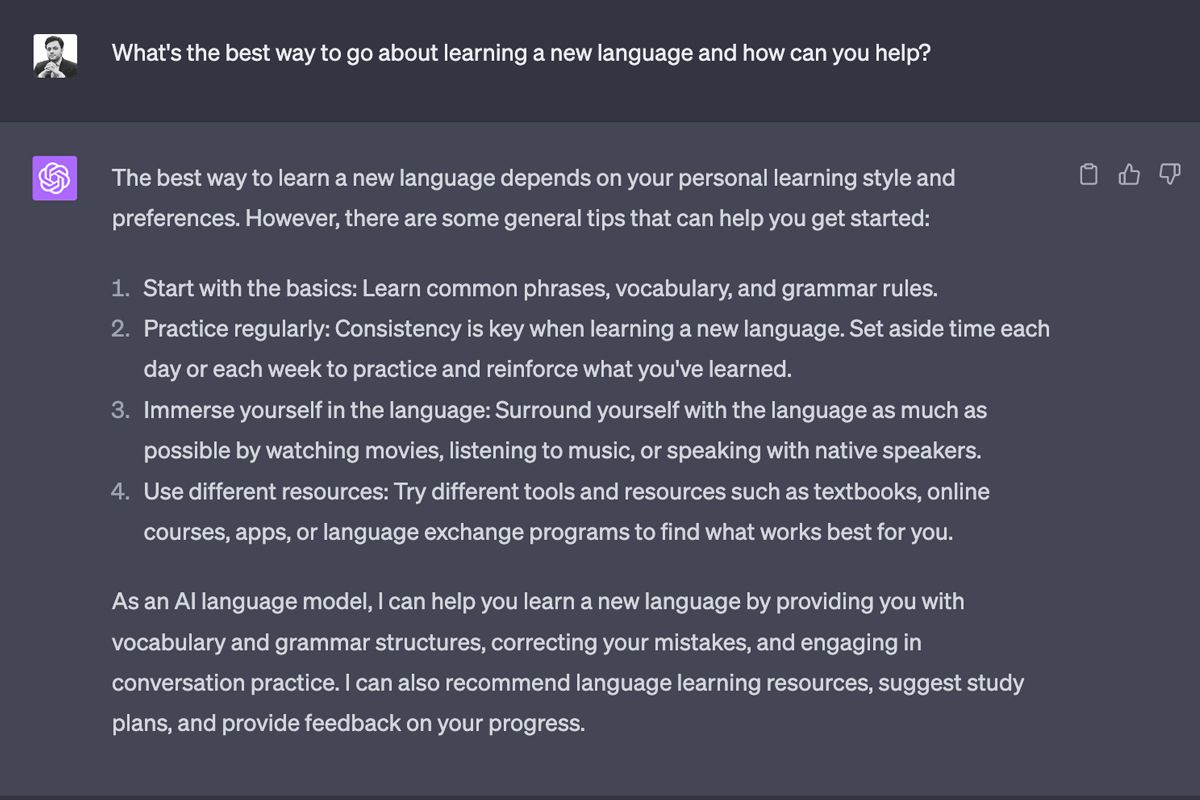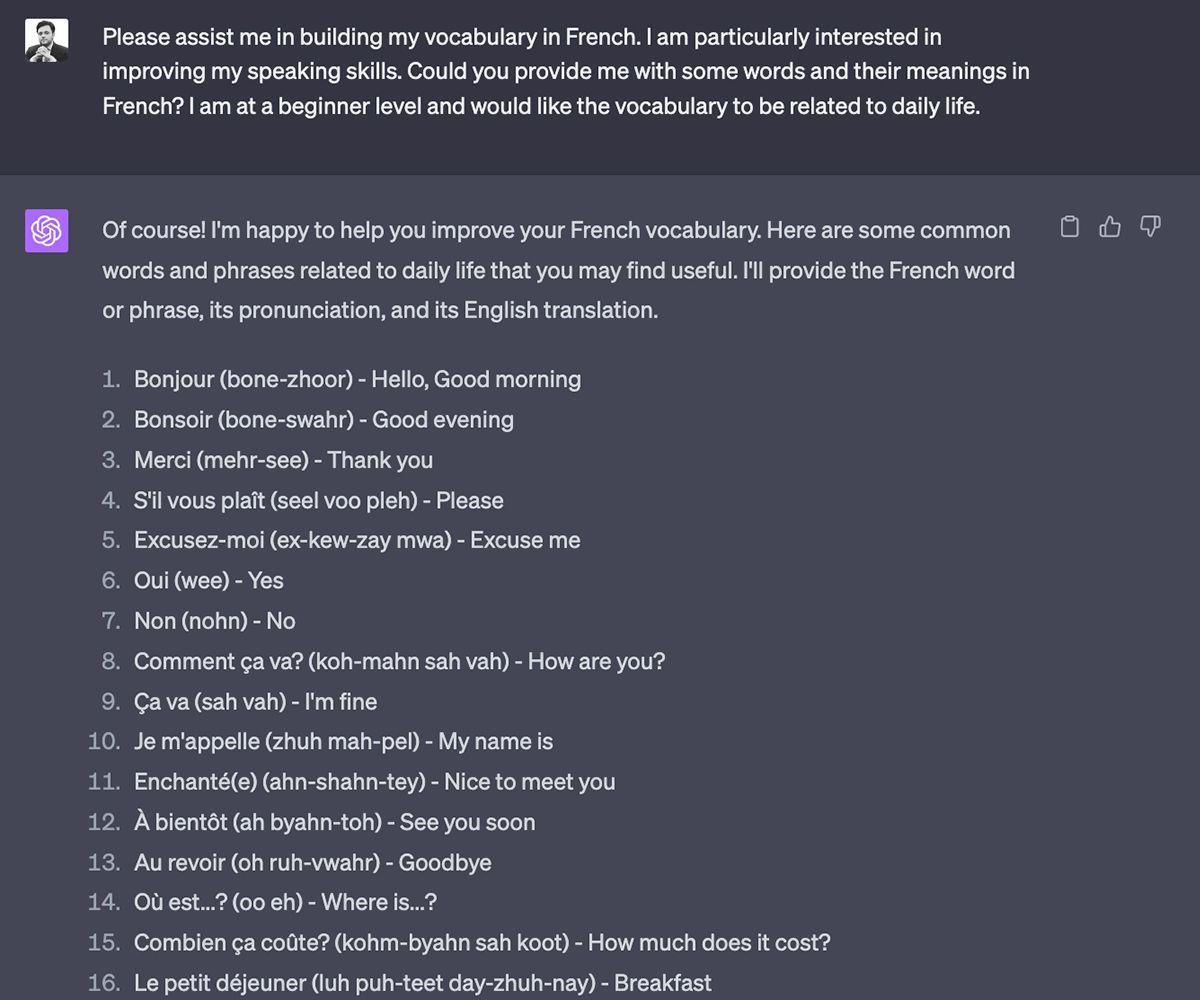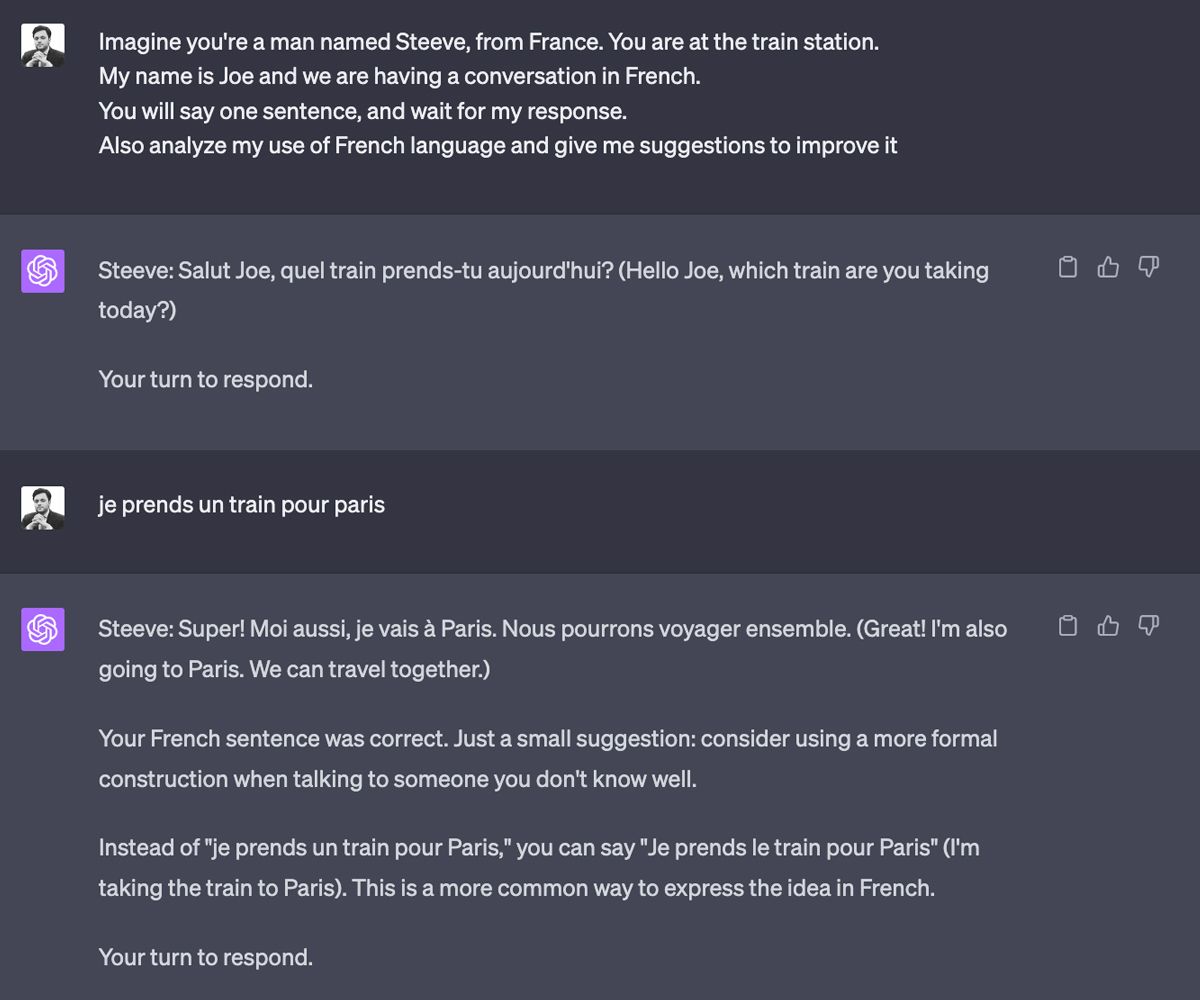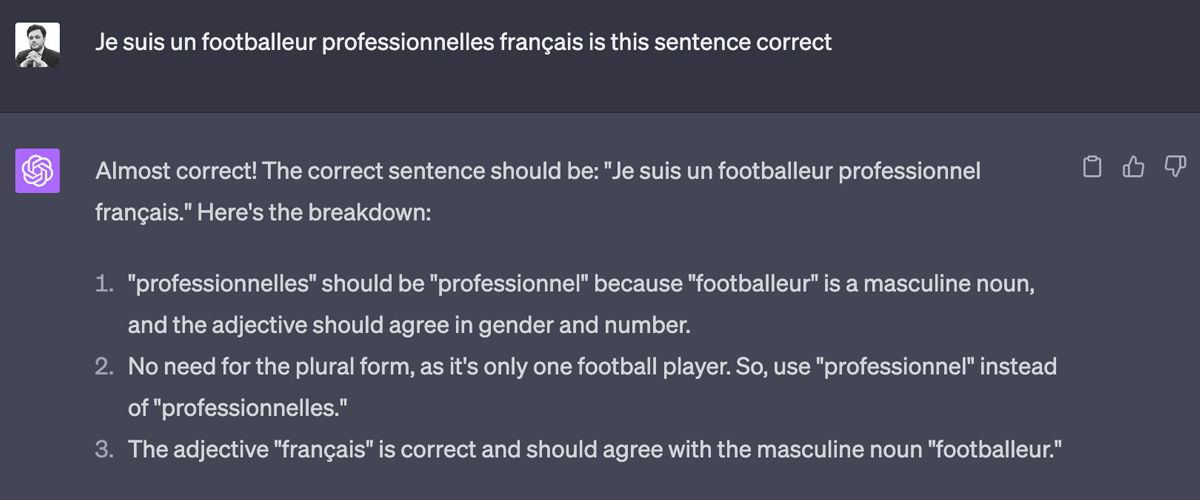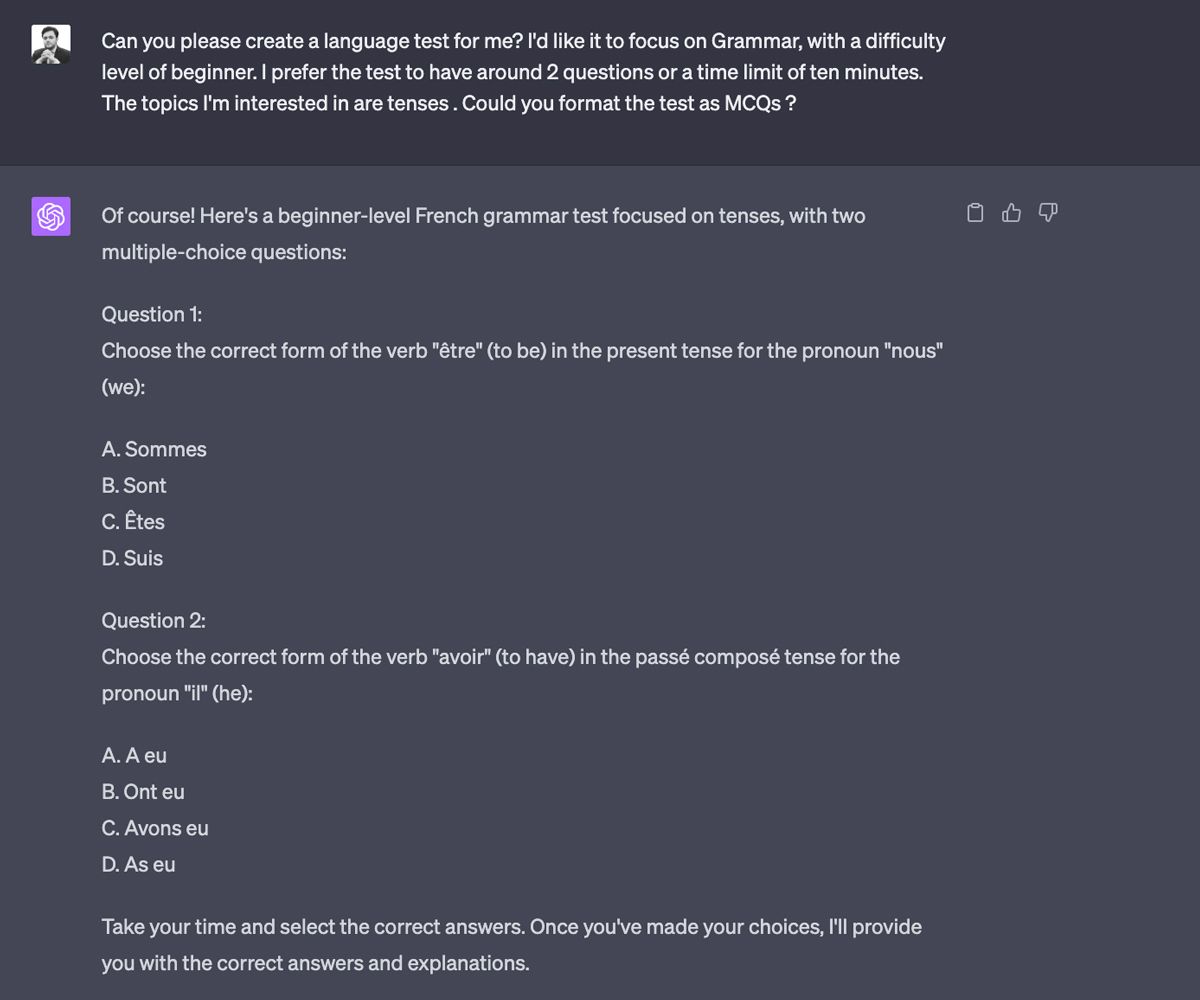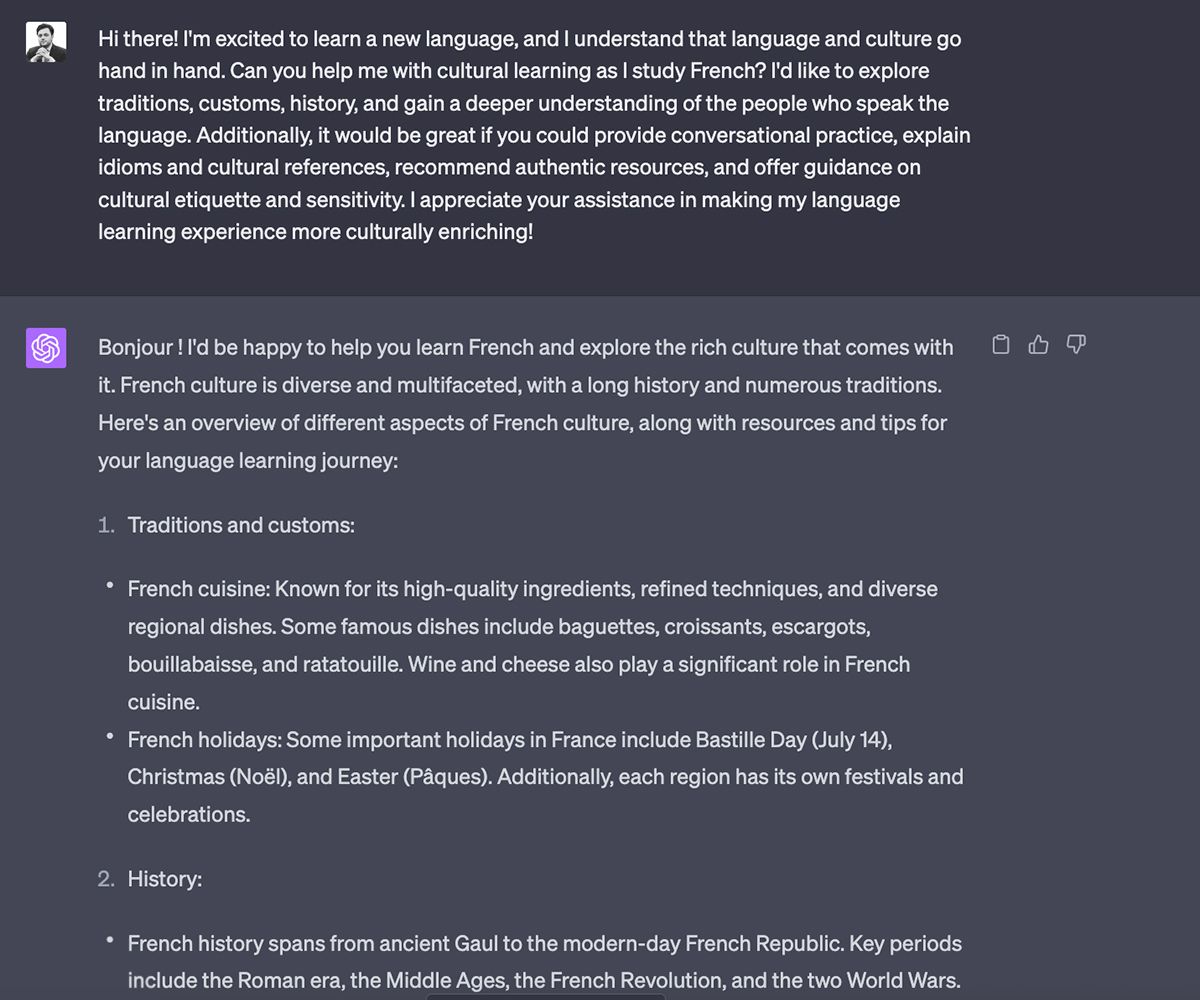For $20 per month, ChatGPT Plus gives you access to GPT-4 and other premium features. GPT-4 is the successor to GPT-3 and has access to more parameters, a better understanding of context, and enhanced problem-solving skills. It turns out that it's also quite good for learning a new language.
Whether you want to improve your French-speaking skills or pick up some German, GPT-4 is surprisingly capable. It can help you build your vocabulary, learn grammar and syntax, and even learn a bit about culture.
1. What's the Best Place to Start?
Naturally, we started by asking ChatGPT about the best place to start and how it can help. ChatGPT recommends that you set clear goals, learn vocabulary in context, listen to and mimic native speakers, and take notes. All of this is solid advice.
It continues by saying that it can help answer questions about grammar and pronunciation, recommend resources, and offer cultural insights. ChatGPT can also provide simple translations. This structures our learning approach better: we now know exactly what we need to ask from ChatGPT during our course of learning a language.
It's important to keep in mind that you pick a language that's relatively easy to learn. English speakers find learning languages such as Mandarin, Russian, and Japanese hard. While ChatGPT can write in all languages, you're better off getting a tutor if you want to nail the pronunciation and overall fluency for the more complex languages.
2. Building Your Vocabulary
Expanding your vocabulary is a good place to start when you're trying to learn a new language. You want to learn how to pronounce common words and understand how/why they are used in various situations. As you can imagine, GPT-4's conversational skills can easily handle this process.
We asked ChatGPT to help us in building our French vocabulary. To be more specific, we told ChatGPT about our proficiency in French and that we wanted recommendations for common words used in daily life. It quickly gave us a list of 20 common words and phrases and their meanings.
An interesting thing of note is that it also explained the pronunciation of each word. This is because we specified that we wanted to improve our speaking skills. We gave the same prompt to GPT-3.5, and it gave us the same list but without the pronunciations.
The result shows that GPT-4 has a better understanding of context in comparison to its predecessor. This is just one of the many differences between GPT 3.5 and GPT-4.
3. Practice Conversational Skills
While learning certain words and phrases in a vacuum is good, all that practice is wasted if you don't build conversational skills. With ChatGPT, you can hold conversations in any language you want. For example, we asked ChatGPT to talk with us in French, and the result was impressive.
ChatGPT understood our prompt immediately and gave us a sentence in French. We then responded to that sentence, and the conversation kept going from there. Throughout this conversation, it critiqued our conversational skills and provided small suggestions.
GPT-3.5 also worked well here. However, it responded with much longer responses and, at times, completely forgot to critique our writing/speaking skills. It still works, but you'll have to occasionally remind the language model about its mistakes.
4. Learn Grammar and Syntax
Grammar and syntax provide the structure and rules necessary to communicate and understand others. ChatGPT can help you learn the grammar and syntax rules by providing real-time feedback, explanations, and examples during written interactions. Since ChatGPT is all about interactivity, it does a better job here than most language-learning apps.
GPT-4 also does a great job of continuing the natural flow of conversation. Keep talking to ChatGPT, and it will point out grammatical errors. Once you understand those errors, you can continue with the conversation. Since ChatGPT learns from your conversations, the responses and critiques improve over time.
5. Personalized Tests
Quizzes and tests are a common feature of most language learning apps. It helps you to check your progress and determine your weak points. ChatGPT is quite good at creating such tests, but you must be creative with the prompts.
We asked GPT-4 to construct a language test for us in French. It crafted a beginner level-quiz, remembering that we were new to the language from the previous context.
Here's how you can create your own personalized tests:
- Specify the type of language test you want. It can be focused on vocabulary, grammar, or reading and writing.
- Choose a difficulty level such as beginner, intermediate, or advanced.
- Determine the test length by specifying the number of questions. You can also set a time limit, but you'll have to time yourself.
- Select your preferred format for the test. It could be a multiple-choice, true or false, or even a traditional short question/answer format.
6. Cultural Learning
Languages and cultures are closely intertwined. By learning a new language, you can gain insight into the traditions, values, customs, and history of those who speak the language. While learning a language with ChatGPT, you can ask for cultural context, references, and social norms that are present in the language. This helps you understand how native speakers communicate.
You can also get insights into cultural phenomena such as historical events, festivals, celebrations, and more. Then, you can ask ChatGPT to provide you with resources such as movies, books, and music in the language you're trying to learn. The key here is to ask anything you can think of about the language and culture.
7. How Does It Compare to Other Alternatives?
ChatGPT has significant advantages over traditional language learning applications. While traditional language learning apps rely on pre-programmed responses, ChatGPT Plus can provide a more personalized and tailored experience. This way, ChatGPT can adapt to your individual needs and set the pace accordingly.
You also get detailed explanations, examples, and cultural insights about the language and the people who speak it. Language apps can do this to some extent, but ChatGPT Plus is more versatile and flexible.
ChatGPT Plus may not provide you with the speaking or listening capabilities to help with pronunciation that other language-learning apps have, but it acts as your teacher that understands context and your progress. These two items help expedite your journey of learning a new language—something no other app can really do.
ChatGPT Is the Perfect Partner for Learning a New Language
The problem with language learning apps is that you often feel like you're all on your own. This isn't something you'll run into when you use ChatGPT. Since it's all about conversation and the constant back and forth, you feel like you're discussing your issues with a partner. If you're someone who prefers an interactive experience while learning, GPT-4 is worth checking out.


